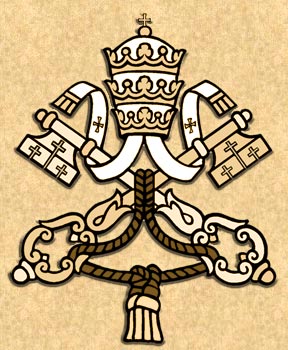
This martyr and patron of France is traditionally held to have been the first bishop of Paris. His popularity is due to a series of legends, especially those connecting him with the great abbey church of St. Denis in Paris. He was for a time confused with the writer now called Pseudo-Dionysius.
The best hypothesis contends that Denis was sent to Gaul from Rome in the third century and beheaded in the persecution under Valerius in 258.
While still very young he was distinguished for his virtuous life, knowledge of sacred things, and firm faith, is proved by the fact that Pope Fabian (236-250) sent him with some other missionary bishops to Gaul on a difficult mission. The Church of Gaul had suffered terribly under the persecution of the Emperor Decius and the new messengers of Faith were to endeavour to restore it to its former flourishing condition. Denis with his inseparable companions, the priest Rusticus and the deacon Eleutherius, arrived in the neighbourhood of the present city of Paris and settled on the island in the Seine. The earliest document giving an account of his labours and of his martyrdom (Passio SS. Dionsyii, Rustici et Eleutherii), dating from the end of the sixth or the beginning of the seventh century and wrongly attributed to the poet Venantius Fortunatus, is interwoven with much legend, from which, however, the following facts can be gleaned.
On the island in the Seine, Denis built a church and provided for a regular solemnization of the Divine service. His fearless and indefatigable preaching of the Gospel led to countless conversions. This aroused the envy, anger and hatred of the heathen priests. They incited the populace against the strangers and importuned the governor Fescenninus Sisinnius to put a stop by force to the new teaching. Denis with his two companions were seized and as they persevered in their faith were beheaded (about 275) after many tortures. Later accounts give a detailed description of the confessors' sufferings. They were scourged, imprisoned, racked, thrown to wild beasts, burnt at the stake, and finally beheaded.
According to one of the legends, after he was martyred on Montmartre (literally, "mountain of martyrs") in Paris, he carried his head to a village northeast of the city. St. Genevieve built a basilica over his tomb at the beginning of the sixth century.









5 comments:
Got a question for you; why does your top post never have a place to leave comments?
The top post which is the contest post is a fixed part of the page much like the image. Hence no comments can be left there.
OK, I didn't realise it wasn't a regular post.
hello
just registered and put on my todo list
hopefully this is just what im looking for, looks like i have a lot to read.
pretty cool stuff here thank you!!!!!!!
Post a Comment